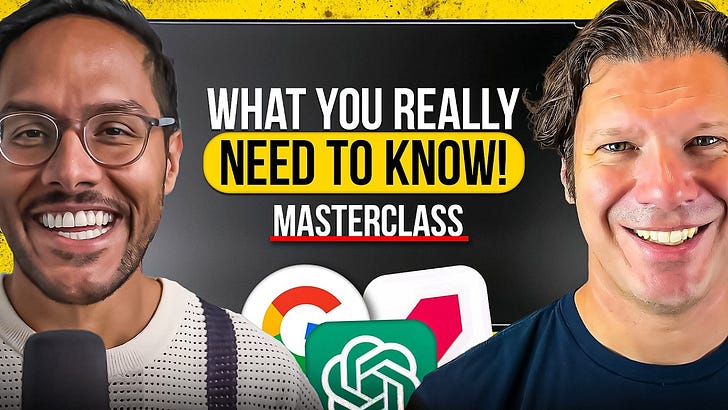Listen now on Apple, Spotify, and YouTube.
Brought to you by:
June.so: Customer analytics for product focused teams
Sprig: Build products for people not data points
Dovetail: The Fastest Way to Understand Your Customer
Junior PM roles are disappearing, outdated frameworks like the Double Diamond are holding you back, and everything you know about product discovery might be wrong.
You’ve probably heard of Pawel Huryn —one of the leading voices in product management, with over 70K+ readers on Substack and 177K+ followers on LinkedIn.
This episode is a masterclass in his best ideas.
The agenda:
Hot Takes on PM – 00:07:40
How to fix the Double Diamond – 00:22:18
Deep Dive Into Product Strategy – 00:44:43
How to Grow on Social Media – 01:12:38
PM Hot Topics – 01:38:07
Here are the Key Takeaways
Here are 5 of Pawel’s most powerful insights:
1. The Double Diamond Framework is Outdated
The traditional Double Diamond framework, often celebrated in the product world, falls short because of its linearity and lack of feedback loops.
Pawel Huryn introduces the Triple Diamond framework, which separates delivery into its own stream and emphasizes continuous feedback between discovery and delivery.
This approach not only minimizes waste but also ensures alignment and iterative improvement throughout the product lifecycle.
The key takeaway? To stay ahead, PMs must ditch outdated frameworks and embrace models that foster adaptability and feedback.
2. Prioritization Made Simple with the ICE Framework
Prioritizing ideas doesn’t have to be overly complicated.
He recommends the ICE framework, which evaluates opportunities based on:
Impact (What’s the potential value?)
Confidence (How sure are we about the results?)
Effort (How much work is required?)
Instead of overthinking with rigid models, ICE encourages practical and actionable prioritization.
Use it as a mental model to focus on high-value opportunities and make faster, smarter decisions.
3. Metrics Must Connect Customer and Business Value
Focusing solely on customer outcomes isn’t enough.
PMs need to tie customer success metrics (e.g., satisfaction or usability) to business metrics (e.g., revenue, retention, and market differentiation).
The Extended Opportunity Solution Tree (OST) serves as a powerful tool to bridge the gap between customer needs and business objectives.
By mapping out both customer opportunities and business priorities, it helps PMs identify and prioritize solutions that achieve a perfect synergy between delivering user value and driving business growth.
4. Risk Management is the Core of Product Management
Managing risks lies at the heart of effective product management.
Four key risks must be addressed:
Value risks: Will customers use or pay for this?
Usability risks: Can customers understand and use it?
Feasibility risks: Can this be built with available resources?
Ethical/go-to-market risks: Is it socially responsible and marketable?
A comprehensive discovery process helps identify and mitigate these risks early, reducing surprises during delivery and ensuring stronger, more reliable outcomes.
5. He Grows with Hooks
When it comes to content creation, Pawel’s success on LinkedIn (100K+ followers in a year) is proof of the power of strong storytelling.
His formula includes starting posts with attention-grabbing hooks, driving action with clear CTAs, and creating authentic, value-packed content that resonates with the audience.
For more details, listen to the full episode now!
Referenced
Book: "The Right It" by Alberto Savoia — it is a practical guide to testing product ideas early, minimizing risk, and ensuring you're building something people truly want.
Strategies/Frameworks:
Lean Canvas — Used for analyzing and designing business models with a focus on product fit.
Product Strategy Canvas — A recommended resource for structuring and refining product strateg
Blog: Marty Cagan’s Blog — Known for deep, philosophical insights on product management.
Where to find Pawel
If you prefer to only get newsletter emails, unsubscribe from podcast emails here.
India Tour! 🇮🇳
We recorded some epic podcasts, and we now have one last event coming up!
Mumbai:
23rd November, Saturday, 11 -1PM: ProductTank Event
Up Next
We have some great podcasts coming from Benjamin Humphrey, Thibault Louis-Lucas, and Melissa Perri. I’m so excited to share them with all of you.
In the newsletter, check out this week’s latest piece if you haven’t yet: How to Nail Your Product Strategy Interview.
And look out for these pieces up next:
Storytelling for PMs
How to Build an Empowered Team
The Criteria for Director + Roles in Big Tech
I think you’re going to love what’s coming up,
Aakash

















